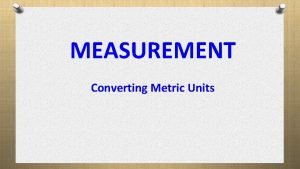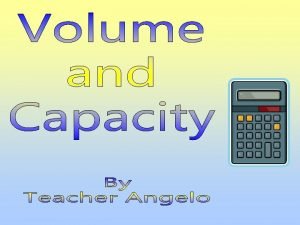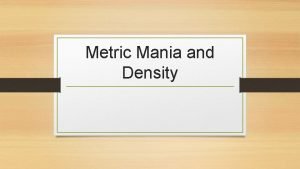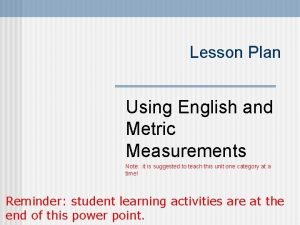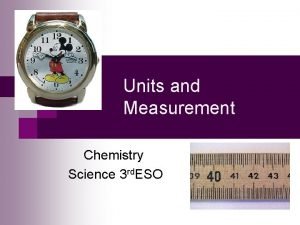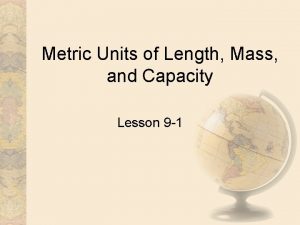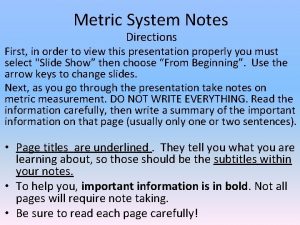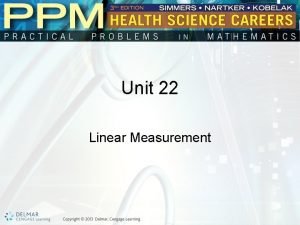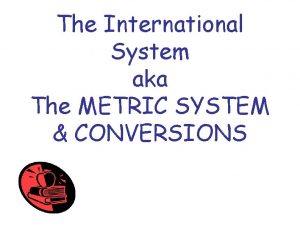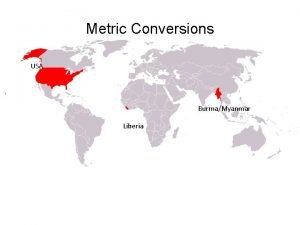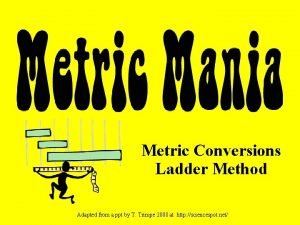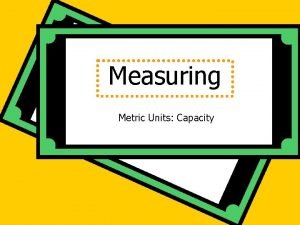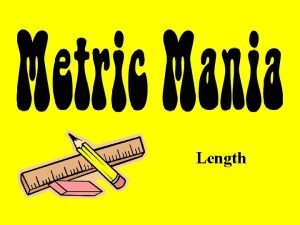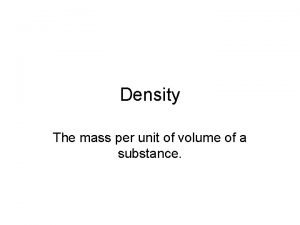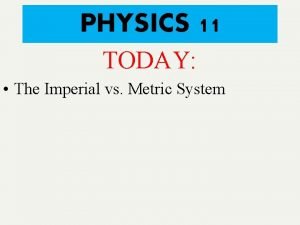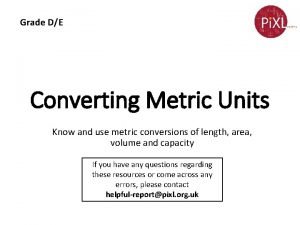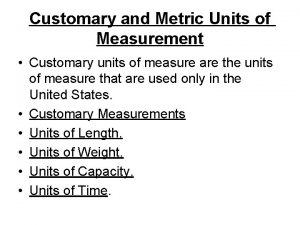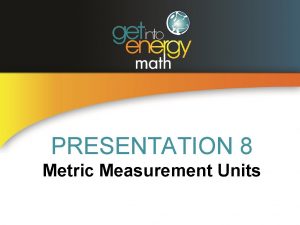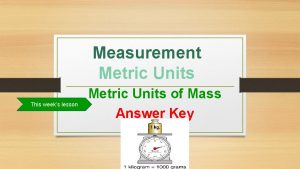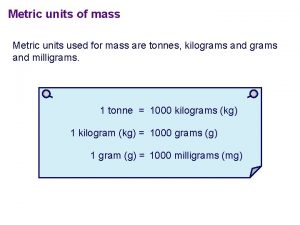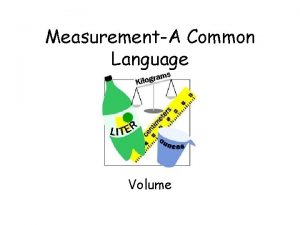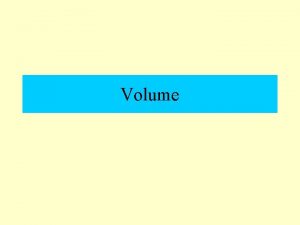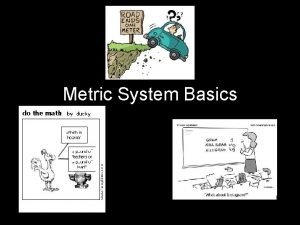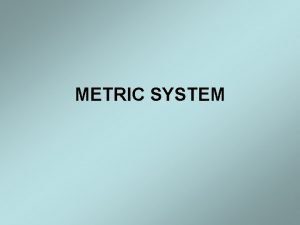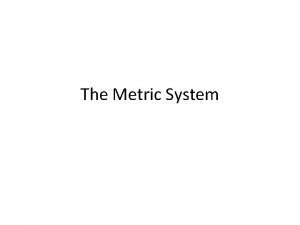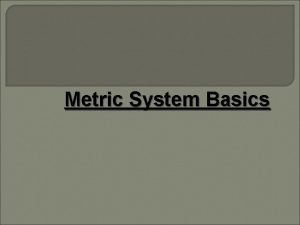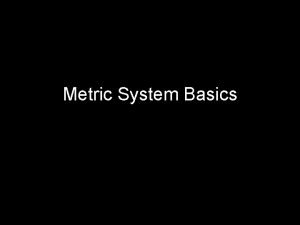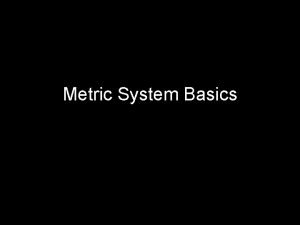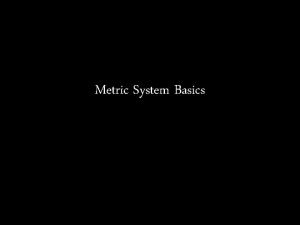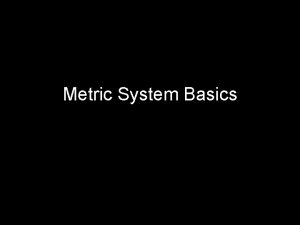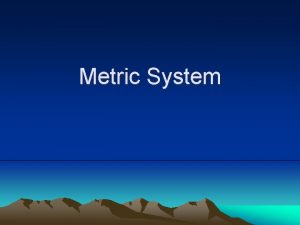Volume Metric Units Volume is the amount of



















- Slides: 19

Volume

Metric Units • Volume is the amount of space an object takes up. • The base unit of volume in the metric system is the liter and is represented by l or cm 3. • We measure volume with a ruler (regularly shaped solid object) or a graduated cylinder (liquids)

Measuring Volume We will be using graduated cylinders to find the volume of liquids and other objects. Read the measurement based on the bottom of the meniscus or curve. When using a real cylinder, make sure you are eye-level with the level of the water. What is the volume of water in the cylinder? _____m. L What causes the meniscus? A concave meniscus occurs when the molecules of the liquid attract those of the container. The glass attracts the water on the sides. Top Image: http: //www. tea. state. tx. us/student. assessment/resources/online/2006/grade 8/science/images/20 graphicaa. gif Bottom Image: http: //morrisonlabs. com/meniscus. htm

What is the volume of water in each cylinder? Pay attention to the scales for each cylinder. Images created at http: //www. standards. dfes. gov. uk/primaryframework/downloads/SWF/measuring_cylinder. swf Measuring Liquid Volume

Measuring Solid Volume 9 cm We can measure the volume of regular object using the formula length x width x height. 8 cm _____ X _____ = _____ We can measure the volume of irregular object using water displacement. Amount of H 2 O with object = ______ About of H 2 O without object = ______ Difference = Volume = ______ Click here for an online activity about volume. Choose Lessons Volume & Displacement http: //resources. edb. gov. hk/~s 1 sci/R_S 1 Science/sp/e n/syllabus/unit 14/new/testingmain 1. htm 10 cm

Length

English vs. Metric Units Which is longer? A. 1 mile or 1 kilometer B. 1 yard or 1 meter 1 mile 1. 6 kilometers C. 1 inch or 1 centimeter 1 inch = 2. 54 centimeters 1 yard = 0. 9444 meters Left Image: http: //webapps. lsa. umich. edu/physics/demolab/controls/imagedemosm. aspx? picid=1167 Right Image: http: //share. lancealan. com/N 800%20 ruler. jpg

Metric Units • The basic unit of length in the metric system is the meter and is represented by a lowercase m. • To measure length we use a ruler or meter stick. Metric Units 1 Kilometer (km) = 1000 meters 1 Meter = 100 Centimeters (cm) 1 Meter = 1000 Millimeters (mm)

Measuring Length How many millimeters are in 1 centimeter? 1 centimeter = 10 millimeters What is the length of the line in centimeters? _______cm What is the length of the line in millimeters? _______mm What is the length of the line to the nearest centimeter? ____cm HINT: Round to the nearest centimeter – no decimals. Ruler: http: //www. k 12 math. com/math-concepts/measurement/ruler-cm. jpg

Mass

Metric Units • Mass refers to the amount of matter in an object. • The base unit of mass in the metric system in the gram and is represented by g. • To measure mass we use an electronic scale or a triple beam balance. Metric Units 1 Kilogram (km) = 1000 Grams (g) 1 Gram (g) = 1000 Milligrams (mg)

Metric Units • Mass refers to the amount of matter in an object. • The base unit of mass in the metric system in the gram and is represented by g. • To measure mass we use an electronic scale or a triple beam balance. Metric Units 1 Kilogram (km) = 1000 Grams (g) 1 Gram (g) = 1000 Milligrams (mg)

Measuring Mass We will be using triple-beam balances to find the mass of various objects. The objects are placed on the scale and then you move the weights on the beams until you get the lines on the right-side of the scale to match up. Once you have balanced the scale, you add up the amounts on each beam to find the total mass. What would be the mass of the object measured in the picture? _______ + _______ = ____ g Top Image: http: //www. southwestscales. com/Ohaus_Triple_Beam_750 -SO. jpg Bottom Image: http: //www. regentsprep. org/Regents/biology/units/laboratory/graphics/triplebeambalance. jpg

Measuring Mass – Triple-Beam Balance 1 st – Place the film canister on the scale. 2 nd – Slide the large weight to the right until the arm drops below the line. Move the rider back one groove. Make sure it “locks” into place. 3 rd – Repeat this process with the top weight. When the arm moves below the line, back it up one groove. 4 th – Slide the small weight on the front beam until the lines match up. 5 th – Add the amounts on each beam to find the total mass to the nearest tenth of a gram.

Metric Conversions King Henry Method

Ladder Method 1 2 KILO 1000 Units HECTO 100 Units 3 DEKA 10 Units Meters Liters Grams DECI 0. 1 Unit How do you use the “ladder” method? 1 st – Determine your starting point. 2 nd – Count the “jumps” to your ending point. 3 rd – Move the decimal the same number of jumps in the same direction. CENTI 0. 01 Unit MILLI 0. 001 Unit 4 km = _____ m Starting Point Ending Point How many jumps does it take? 4. __. __. = 4000 m 1 2 3

Conversion Practice Try these conversions using the ladder method. 1000 mg = _______ g 1 L = _______ m. L 160 cm = _______ mm 14 km = _______ m 109 g = _______ kg 250 m = _______ km Compare using <, >, or =. 56 cm 6 m 7 g 698 mg

Metric Conversion Challenge Write the correct abbreviation for each metric unit. 1) Kilogram _____ 4) Milliliter _____ 7) Kilometer _____ 2) Meter _____ 5) Millimeter _____ 8) Centimeter _____ 3) Gram _____ 6) Liter _____ 9) Milligram _____ Try these conversions, using the ladder method. 10) 2000 mg = _______ g 15) 5 L = _______ m. L 20) 16 cm = _______ mm 11) 104 km = _______ m 16) 198 g = _______ kg 21) 2500 m = _______ km 12) 480 cm = _____ m 17) 75 m. L = _____ L 22) 65 g = _____ mg 13) 5. 6 kg = _____ g 18) 50 cm = _____ m 23) 6. 3 cm = _____ mm 14) 8 mm = _____ cm 19) 5. 6 m = _____ cm 24) 120 mg = _____ g

Compare using <, >, or =. 25) 63 cm 26) 536 cm 6 m 53. 6 dm 27) 5 g 28) 43 mg 508 mg 5 g 29) 1, 500 m. L 30) 3. 6 m 1. 5 L 36 cm
 Metric system conversion
Metric system conversion What is the volume of this aquarium
What is the volume of this aquarium Basic conversions
Basic conversions Metric mania
Metric mania English and metric units
English and metric units Metric system of measurement
Metric system of measurement What are the 7 metric units?
What are the 7 metric units? Length mass and capacity
Length mass and capacity Milli centi deci chart
Milli centi deci chart Units of linear measurement
Units of linear measurement Metric units chemistry
Metric units chemistry Km hec dec m dm cm mm
Km hec dec m dm cm mm Stair step metric conversion chart
Stair step metric conversion chart Conversions using the ladder method
Conversions using the ladder method Metric units of capacity
Metric units of capacity English vs metric units
English vs metric units Mass per unit of volume
Mass per unit of volume Imperial units
Imperial units Units of length
Units of length Customary and metric system
Customary and metric system
